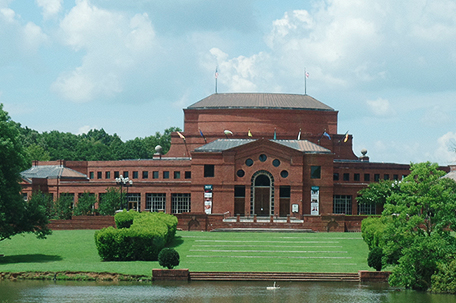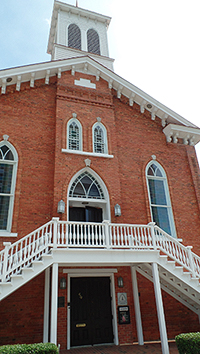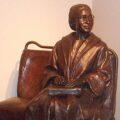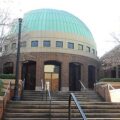
ABOVE PHOTO: Shakespeare Festival Center
by Renée S. Gordon
“Stories are a communal currency of humanity.” –Tahir Shah, Arabian Nights
Until the Civil War the United States developed regionally based on geography, political beliefs and economic interests. Regions were distinct entities and created their own art forms including unique literary styles and even before the birth of America Captain John Smith was producing the first southern literature when he wrote “A True Relation of Occurrences and Accidents in Virginia” in 1608. After the Civil War and the turn of the 20th-century, a Southern Literary Renaissance occurred. Although the authors represent all the southern states and all the literary genres, Alabama’s authors are particularly important because of their lasting impact on our common culture. One of the era’s earliest recurring and most enduring themes was the individual and community response to the legacy of the past. Ancillary themes include race relations, common heritage and recognition of and coming to terms with an emerging society.
Any tour of the United States’ southern literary heritage in Alabama must include the homes and places that were inhabited by the authors. A deeper understanding of the author and their works can be obtained by inhabiting their space, if only for a few minutes on a tour. alabama.travel/TweetHomeAla
Montgomery, Alabama was created from two villages, New Philadelphia and East Alabama, in the 1800s and Montgomery can make a strong case for being at the nexus of the Civil War and Civil Rights. Slaves were sold in a market on Court Street and across the street stood the Winter Building’s telegraph office from which Jefferson Davis sent the telegram to fire on Fort Sumter, thereby beginning the Civil War. On December 20, 1956, Rosa Parks boarded a bus at the Court Square Bus Stop and into history. visitingmontgomery.com/twitter.com/mgmcapitalcool
Martin Luther King, Jr. began his journey into history in Montgomery and although most people recognize his superior oratorical skills they do not always make the association that he was an equally brilliant writer and today, more than one million documents are preserved that allow future generations to more fully comprehend his genius. King, though considered radical at the time, called on the long-standing traditions of the enslaved and free African American churches as sites of solace, funds, manpower and community dissent and planning. His overall, personal philosophy was developed over time and synthesized the views expressed by philosophers, theologians and leaders such as Gandhi and Thoreau.
At the age of 25, in February 1954, King became the pastor of the Dexter Avenue Baptist Church. The next year was an important one for King. He submitted his doctoral dissertation, “A Comparison of the Conception of God in the Thinking of Paul Tillich and Henry Nelson Wieman” and was awarded a Ph.D in systematic theology from Boston University. He was elected president of the Montgomery Improvement Association (MIA) and began to organize a bus boycott to protest the city’s Jim Crow transportation laws. The MIA made three demands; that the drivers be courteous to blacks, that seating be on a first come first served basis and that black drivers be hired to service black neighborhoods. The boycott lasted 381 days and ended on December 20, 1956 with a loss to the bus company of approximately $3000.00 per day. The boycott resulted in a reaffirmation of a lower court’s ruling, by the Supreme Court in Browder v. Gayle, that Alabama’s laws on segregated seating were unconstitutional. The two single most important King interpretive sites in Montgomery are the Dexter Avenue Baptist Church and the Parsonage Museum.
Dexter Avenue King Memorial Baptist Church was established in 1877, in what had functioned as a slave pen, as the Second Avenue Colored Baptist Church. William Watkins, a black builder, constructed the building of bricks that were left from the 1883 paving of the street on the $270.00 plot of land. The church served as the leadership site during the boycott and the place where Parks first related her story to the community. The exterior of the church has a semi-circular staircase. Tours of the interior are regularly scheduled and may be booked in advance.
Tours of the interior begin on the lower level where a mural, painted in 1980 by John Feagin is featured. The 10’ by 47’ mural depicts historic participants in the struggle for civil rights as well as scenes from the life of MLK. The highlight of the displays is King’s historic podium. It continues in use today by the current pastor and was used in the movie Selma. In what was once his office visitors can view the original desk and the last financial report he submitted. The sanctuary is furnished with original pews and original chairs. The 1889 archway was carved from one oak tree. Claudine Parker originally developed Dexter Avenue Church Tours. She was the first victim of the D.C. Sniper. In 1974 the church was designated a National Historic Landmark. dexterkingmemorial.org
The Dexter Parsonage Museum is where one can visualize the life of both King the man and King the Civil Rights Leader. Tours begin with a video in the adjacent visitor center, “From Man to Movement.” The nearby 1912 home was purchased by the church for the pastor and when Martin and Coretta arrived they had been wed two months. At 9 PM on January 31, 1956 while King was out and Coretta and their 10-month old daughter were at home the parsonage was bombed. Visual residue of the event can still be seen on the right side of the porch in the form of a small crater. A crowd of supporters gathered after the bombing and King dispersed them with a renewed commitment to the struggle. After a second bombing that destroyed the façade of the home, seven white men were arrested and even though two confessed, they were all found innocent at trial.
Tours proceed through the single story house, outfitted with numerous family belongings and furniture and replicates what the home looked like during the Kings’ residence. Highlights include his office and personal book and record collection. On January 27, 1956 King received a threatening phone call so menacing that he was compelled to contemplate the consequences of his actions on his family and assess the depth of his commitment. It is in this kitchen that he prayed and experienced an epiphany, an inner voice that eradicated his doubts and clarified his path. On the kitchen table there is a bouquet of artificial flowers. King was in the habit of sending Coretta fresh flowers when he was away. The last flowers he sent prior to his assassination were artificial and when Coretta asked why he responded that he wanted to give her something that would last. This site is extremely moving and must be experienced.
The parsonage was placed on the National Register of Historic Places in 1982 and was restored in 2003 by the Dexter Avenue King Memorial Foundation. dexterkingmemorial.org
F. Scott Fitzgerald was born in 1896 in Minnesota. He attended Princeton but dropped out and joined the army in 1917. While at Camp Sheridan near Montgomery, he met Zelda Sayre Fitzgerald in 1918 and married her in 1920. Fitzgerald was recognized as the chronicler of the Jazz Age from the 1920 publication of his first novel, “This Side of Paradise,” onward. The novel was a success and made the young couple wealthy and socially prominent. Scott’s works are largely autobiographical and uniquely capture the point of view of both the observer and the observed. His life, as well as Zelda’s would burn brightly, characterized by “wretched“ excess in all things, alcoholism, mental health issues and stunning literary accomplishments. Throughout the vicissitudes of their lives they continued to love one another and theirs is a “truer” love story than most.
The Fitzgerald’s lived in Montgomery at various times but their last existing family home, eight months in 1931-32, has become the F. Scott and Zelda Fitzgerald Home and Museum. The first floor of the 1910 house presents thematic displays that tell their story through artifacts, photographs and documents. The museum also houses the second largest collection of Zelda’s artwork.
They moved in one month after Zelda’s release from a Swiss clinic where she underwent treatment for a nervous breakdown. Both of them worked on novels while living there, Scott’s, “Tender is the Night,” is the tale of a marriage in which the wife struggles with mental illness and the husband descends into alcoholism as a coping mechanism. His novel was published in 1934 and it is said that he considered it his finest work. While residing there Scott left to work in Hollywood, leaving Zelda alone, and on February 12, 1932 she suffered another breakdown and was hospitalized in Johns Hopkins in Baltimore. Scott died of a heart attack on December 20, 1940 in Hollywood. Zelda died in a fire on March 10, 1948 at Highland Hospital in Montgomery. They are interred side by side at St. Mary’s Church in Rockville, Maryland.
Ironically much of Fitzgerald’s enduring fame can be credited to the World War II Armed Services Book Editions. The US Government gave away more than a million books, approximately 1,000 titles, to men serving in the army and prisoners of war and around 123,000 copies of “The Great Gatsby” were among them. These paperback books were sized to fit in a pocket and each man was given a book as he boarded a landing craft in England at the D-Day launch. Though not depicted in the movies, many of the men were probably reading on their way to Normandy Beach. thefitzgeraldmuseum.net
Shakespeare is not exactly a southern writer, but no literary trip to Alabama can be complete without a mention of the Alabama Shakespeare Festival. The festival began in Anniston, Alabama in a high school auditorium but, after a lack of financial success, Wynton Blount agreed to underwrite the costs if the festival would relocate to a 250-acre park setting in Montgomery. Mr. Blount’s donation of $21.5-million remains the single largest donation to American theater. The Carolyn Blount Theater complex includes he festival Stage and the Octagon Theater as well as offices, work shops and rehearsal halls. The landscaping replicates English garden and lake spaces. Performances are held year round. asf.net
Martha’s Place Buffet and Catering is a Montgomery legend that is owned and operated by the remarkable Martha Hawkins. She was born one of 12 children and is the mother of 4 sons. She overcame poverty and clinical depression and sought ways to change her life. She looked to the life of Georgia Gilmore, a local resident who prepared meals in her home for Robert Kennedy and MLK and Martha opened her first restaurant in her home and ultimately opened a larger establishment featuring a southern buffet. Her first large-scale catering job was on the set of Maya Angelou’s “Sister, Sister” and she has been featured in numerous publications including “Oprah”. She employs those in need of a second chance and her staff of 23 adores her as much as the public does. She has become a much sought after international speaker and author of an autobiography and soon to be released cookbook.
Martha’s is ground zero for comfort food. Fried chicken is her specialty and all of her vegetables are cooked with smoked turkey instead of pork. The restaurant is open daily. Best of all her dishes are devoid of calories because Martha says she “prayed them all away”. www.marthasplacebuffet.com
Montgomery’s Embassy Suites Hotel and Conference Center, in the entertainment district, is within walking distance of many attractions and is a solid choice for accommodations. The all-suite hotel offers all the amenities and free WIFI and complimentary evening reception and full breakfast. Rooms offer views of the Alabama River and the hotel is pet friendly. embassysuites3.hilton.com
I wish you smooth travels!
Travel Tips
To make the most of our literary tour read these along the way:
“A Testament of Hope : The Essential Writings and Speeches of Martin Luther King, Jr.”
James Washington, editor
“Martin Luther King, Jr., Heroism, and African American Literature”
Trudier Harris
“The Great Gatsby”
F. Scott Fitzgerald
“Tender is the Night”
F. Scott Fitzgerald
“Finding Martha’s Place”
Martha Hawkins


















Leave a Comment